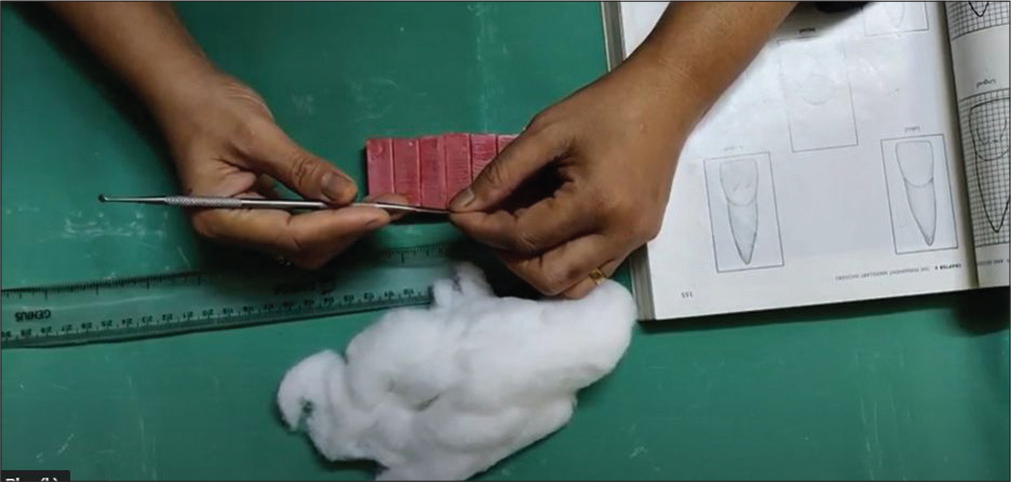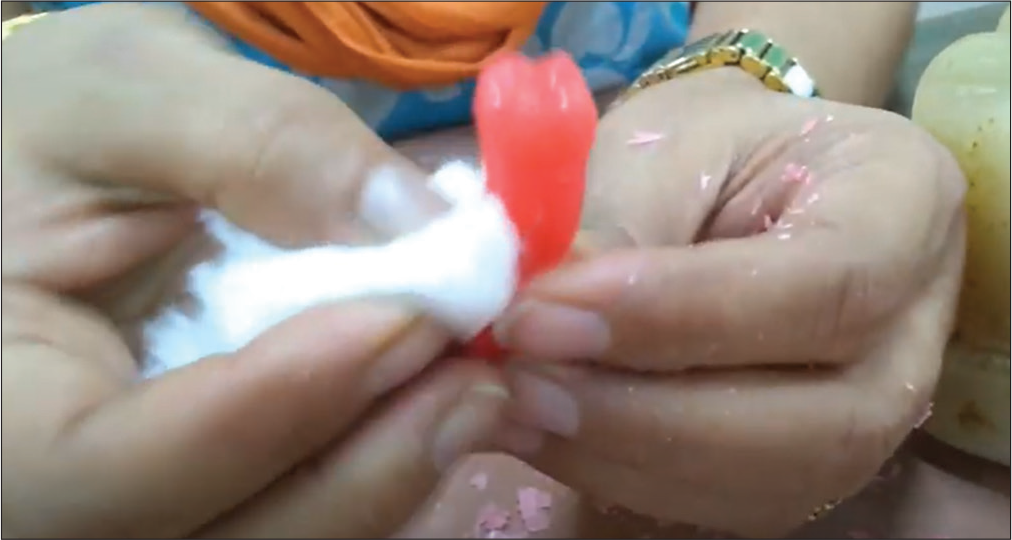Translate this page into:
Tooth carving exercise as a foundation for future dental career – A review

*Corresponding author: Sandhya Tamgadge, Professor, Department of Oral and Maxillofacial Pathology, D.Y. Patil University School of Dentistry, Mumbai, Maharashtra, India. sandhya.tamgadge@dypatil.edu
-
Received: ,
Accepted: ,
How to cite this article: Nayak A, Tamgadge S. Tooth carving exercise is foundation for future dental career – A review. J Acad Dent Educ 2022;8:42-4.
Abstract
The curriculum of the bachelors of dental surgery has been intricately weaved with the exposure to appropriate theoretical and practical skills at the right age. This enables the students to develop proper dexterity toward using more complex instruments as the students reach final year. Learning tooth carving in the 1st year of the course curriculum serves as a vital step in establishing this dexterity. This review brings about different clinical applications of learning carving and its role in the dental curriculum.
Keywords
Carving
Tooth
Curriculum
Foundation
Dentistry
INTRODUCTION
Tooth carving on wax blocks is an integral part of the 1st-year undergraduate dental curriculum. It is a pre-clinical exercise consisting of construction of different types of teeth, namely, the incisors; canines; premolars, and molars, according to the anatomical landmarks as present in the permanent teeth. This exercise involves use of wax blocks and a Lecron’s carver. The role of tooth carving is to develop a basic understanding of the anatomic landmarks of the tooth which help in assessing the disease progression with the help of such landmarks as the course curriculum progresses and planning treatment measures accordingly.[1,2]
ARMAMENTARIUM
Paraffin wax block – The principal element of carving is the wax block
Lecron’s carver – The carving tool
Cotton – Used to clear minor scratches from the carving leading to better visibility of finer details. Other materials which are used are gauze piece and tissue paper
Soap and water – for polishing the final carving
Reference material
Macintosh sheet to collect wax shavings [Figure 1].

- Armamentarium for carving.
TOOTH CARVING TECHNIQUE
Dental anatomy involves teaching anatomic differences between deciduous and permanent teeth, chronology of tooth eruption in deciduous and permanent teeth, and anatomy of the roots of the teeth.[3]
The construction of basic shapes to develop appropriate motor skills is taught before teaching the actual tooth carving. Following which, the crown anatomy is taught beginning from the buccal, lingual, mesial, and distal reduction of the wax block according to the shape of the tooth. Later, the occlusal aspect in case of posterior teeth and lingual aspects in case of anterior teeth are taken into consideration. After the crown morphology, roots of the teeth are carved depending on the tooth and the subsequent root numbers involved.[3]
There are three different types of grips that are used to hold carver [Figure 2]

- Different types of grasps (a) palm and thumb grasp, (b) modified pen grasp/grip, (c) pen grasp/grip, and (d) carving demonstration.
Pen Grasp.
Modified Pen Grasp (most commonly used). Index finger guides the stroke of the carver. Middle finger gives rest point to the carver. Thumb supports the carver
Palm and Thumb Grasp.
ENHANCED LEARNING FROM TOOTH CARVING
As described by Neil Fleming, the various sensory modalities adopted for learning include the visual method [Figures 3 and 4], aural or auditory method, reading or writing method and kinesthetic method and tell show do method.[4] Digital methods such as recorded videos are uploaded online for student reference.[4]

- Explain through models.

- Polishing step.
All the four methods are adopted in the process of tooth carving to enable better learning. In addition to the skills, development of patience is also observed since it is a time consuming activity. In the long run, it proves to be a necessity for a dentist to carry out an array of simple as well as complex treatment procedures.[4]
APPLICATION OF THE KNOWLEDGE GAINED FROM CARVING IN VARIOUS FIELDS OF DENTISTRY
Oral radiology – This field involves diagnosis of various anomalies visible radiographically. Understanding the morphology would enable proper understanding of the difference between normal and abnormal variations in the tooth.[5]
Oral surgery – Understanding the actual depth of roots of the teeth in the oral cavity can enable dentists to ensure that there are no root pieces or any other abnormalities occurring in the process of extraction.[5]
Prosthodontics – Smile designing is an essential part of prosthodontics which will favor understanding of the contours of the teeth and also presence of overjet and overbite. Carving also plays an integral role in fabrication of fixed and removable prostheses.[5]
Conservative dentistry and endodontics – Carving in tooth fillings is an essential component in restoring the normal anatomic structure and function of the tooth. It is said that an appropriate carving on amalgam restorations lasts for up to 30 years. The occlusal anatomy especially plays a major part in restoring teeth. Morphology of the roots aids in endodontics.[5]
Periodontology – Proper removal of plaque and calculus can be achieved with proper development of manual dexterity especially in hand scaling.[5]
Forensic odontology – Tooth morphology is essential to aid in forensic investigations as identifying a tooth from deceased becomes difficult with the lack of knowledge on the tooth morphology in living beings.[5]
Community dentistry – Differentiating between non-diseased and diseased teeth can aid in epidemiological surveys.[5]
ADVANCEMENTS IN TOOTH CARVING EXERCISES
Tooth carving enhances the proficiency of different grasps and instrument application techniques that enable the students to practice toward perfection in their clinical practice. Different technologies and advancements that can aid the students in tooth carving include.
Supplementary online dental academy resources – These include the use of online videos to understand concepts and step by step tutorials on tooth carving.[6]
Carving tooth models – These include the use of pre-prepared models in step-wise pattern on the conventional wax block or wax block of larger size to demonstrate the anatomical landmarks in a lucid format.[7,8]
CONCLUSION
By learning tooth carving, appropriate understanding of the morphological structure of the tooth is instilled into students along with development of psychomotor skills, identification of teeth, recognizing and diagnosing tooth anomalies, and disease progression for making appropriate decisions on treatment planning depending on the severity of the case.
Declaration of patient consent
Patient’s consent not required as there are no patients in this study.
Conflicts of interest
There are no conflicts of interest.
Financial support and sponsorship
Nil.
References
- Role of computer-based learning in tooth carving in dentistry: An Indian perspective. Int J Appl Basic Med Res. 2016;6:164-5.
- [CrossRef] [PubMed] [Google Scholar]
- The perceived relevance of tooth carving in dental education: Views of practicing dentists and faculty in West India. Educ Health (Abingdon). 2014;27:238-42.
- [CrossRef] [PubMed] [Google Scholar]
- Relevance of innovative course modules for teaching tooth morphology in today's scenario. J Oral Maxillofac Pathol. 2021;25:23-4.
- [CrossRef] [PubMed] [Google Scholar]
- Enhancing dental carving skills of preclinical dental hygiene students using online dental anatomy resources. Open Dent J. 2019;13:499-504.
- [CrossRef] [Google Scholar]
- Self-directed study and carving tooth models for learning tooth morphology: Perceptions of students at the University of Aberdeen, Scotland. J Dent Educ. 2013;77:1147-53.
- [CrossRef] [PubMed] [Google Scholar]
- Available from: https://www.youtube.com/channel/UCk1nmobCU4vN5xb-XwHNseQ [Last accessed on 2022 10 Aug]







